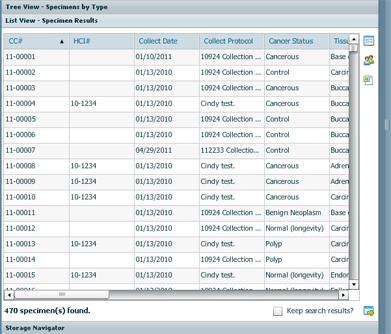- Welcome
- Use case
- Getting Started
-
Searching Records
- Performing a Basic Search
- Performing an Advanced Search
- Performing a List Search
- Performing a Keyword Search of UUMC Pathology Reports for all Patients in the Database
- Performing a Keyword Search of UUMC Pathology Reports for the Patients Associated with a Specific Set of Specimens
- Restrictions on Searches
- Reports
-
iQ Tool
- Adding Columns to a Query
- Starting the iQ Tool
- iQ Tool Window
- Current Query Data Group
- Saved Queries List
- Top Portion of the Selected
- Display or Report Columns Section
- Find/Filters Section
- Running a Preexisting Query
- Creating a Query
- Create Query Window
- Copying and Altering a Preexisting Query
- Removing Columns from a Query
- Editing Column Parameters in a Query
- Changing the Order of Columns in a Query
- Adding Filters to a Query
- Editing Filters in a Query
- Ways of Comparing Data
- Removing Filters From a Query
- Results Window
- Application Data Structure
- Application Database Fields Alphabetical List
- Application Datatree
- Field Paths List for the iQ Tool
-
Adding Specimens to the Database
- Adding a Single Specimen using the Add Specimen Wizard
- Adding a Batch of Specimens using the Add Specimen Expert Tool
- Saving a Batch of Specimens to be added as a Work in Progress
- Finishing a Work in Progress Batch
- Printing Barcodes for a Specimens in a Batch added using the Add Specimen Expert Tool
- Customizing the Add Specimen Expert Tool to Streamline Specimen Batch Entry
- Changing which Box an Add Expert Template Points for Adding Storage
- Importing FFPE Samples from UUMC
- Entering and Editing Specimen Records
- Transformations
- Specimen Disbursement and Registration
- Reports and Records
- Adding a Pathology Report to a Specimen Record
- Performing a DEXT Import of a Pathology Import
- Checking on the status of your DEXT Import Request
- Adding a Medical Record to a Specimen Record
- Editing Patient or Collection Records
- Editing Collection Records
- Editing Patient Records
- Diagnoses
- Adding a Diagnosis to a Patient Record
- Linking an Existing Diagnosis to one or more Collections
- Linking a Collection to a Diagnosis
- Recording a Consent for a Patient
- Reviewing a Patient's Consents
- Uploading a Patient's Consent Form
- Managing Patient Consents
- External (to itBioPath) Data Sources
- Managing Dictionaries
-
Storage
- Editing Aliquots
- Connecting a Barcode Label Printer to itBioPath
- Removing a Barcode Label Printer from itBioPath
- Freezer Management
- Viewing the Contents of a Box in a Freezer
- Accessing the Specimen Record for the Specimen associated with an Aliquot
- Editing Box Details
- Adding a New Box to a Freezer from the Add Aliquot Window
- Managing Protocols, Projects, and Related User Permissions
- Window, Tab, and Field Descriptions
- Miscellaneous
This process will perform a keyword search of UUMC Pathology reports from a list of search results. For instructions on how to perform a more general path report keyword search, see Performing a Keyword Search of UUMC Pathology Reports for All Patients in the Database.
This search is performed at the patient level. UUMC Path reports are associated with patients, not with specific specimens. The results are samples from patients that match the criteria that also happen to have already been included in the list of candidate samples included in the original keyword search. To identify the specific matching samples, you may need to compare the sample collect or consent date to the ITS path report of interest unless your previous search has already eliminated samples from the patient that could not be related to the path report in question.
The specimens identified in this process not only are associated with a patient who has a path report that contains the specified keywords, but the date of that path report is required to be within a few days of the collect date of that specimen, increasing the likelihood that the path report and specimen are directly related.
To perform a keyword path report search among a specific set of specimens:
1. Conduct a search for a desired set of specimens. You may use any search method to do this.
The keyword search accesses the Enterprise Data Warehouse directly, and as a result, it may take a while. For this reason, it is a good idea to reduce the list of specimens as much as possible before continuing.
2. Switch to List View in the results area of the search pane.

3. Make sure specimen results are selected (rather than patient results).

4. Click on the Show More button in the lower right corner of List View. The Pathology Diagnosis Text fields will appear along the top part of the List View pane.

5. Enter the appropriate keyword search terms in the Pathology Diagnosis Text fields on the window.

6. Select the appropriate radio button next to the Pathology Diagnosis Text fields to specify if the resulting matches should contain all of the terms or only at least one of the terms.

7. Click on the Find button. The rows with the specimens returned as a result of the text keyword search will be highlighted in yellow in the List View grid.

The other specimens — the ones not matching the keyword search — will still be listed in the grid. They just won't be highlighted in yellow. The number of specimens matching the keyword search is listed next to the Find button so that you know how many highlighted rows there are.




